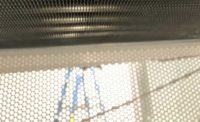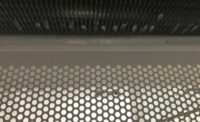Active chilled beams systems employ hydronic sensible cooling with low fan power, which makes them potentially more energy-efficient than the traditional air-based HVAC systems. Revision to ANSI/ASHRAE/ASHE Standard 170-2008, Ventilation of Health Care Facilities, allows recirculated air to be part of the total minimum air change rate requirements, which in turn allows the use of active chilled beams into patient rooms.
Active chilled beams (ACB) distribute cold supply air through linear diffusers and induce hot return air back into the cooling coil located inside the unit. Air is the primary carrier of heat, moisture, contaminants, and airborne pathogens in occupied spaces. Therefore, the distribution of supply air determines the resulting air velocities, temperature, and concentration of contaminants and airborne pathogens at various locations in a patient room. Such distribution in turn determines thermal comfort, air quality, and potential for transmission of airborne infectious pathogens in healthcare facilities such as patient rooms, isolation rooms, and operating rooms.
The airflow patterns, temperature distribution, and concentration of contaminants including the distribution of airborne pathogens in a patient room depend on several interrelated factors including the location and orientation of active chilled beams, supply air flow rates (air change rates) and associated induction air flow rates, supply air temperature, bathroom exhaust flow rates, locations and strengths of various heat sources in a room, arrangement of furniture and other obstructions to airflow, and relative location of the patient in the room.
In addition, orientation of the room can determine the solar sensible heat loads in the room. Successful design and operation of ACB requires a careful examination and in-depth understanding of the impact of these variables on the airflow distribution in a patient room. Such understanding is difficult to obtain from the routine system level design processes. Importantly, realization of a poor airflow distribution in a space after its occupancy is often too late to make any physical modifications and may jeopardize the reputation of a design firm.
Computational fluid dynamics (CFD) analysis can provide a convenient approach for airflow visualization including temperature distribution, concentration of contaminants, etc., in a three-dimensional virtual space that can provide verification of HVAC design. Additionally, CFD can help provide in-depth understanding of various design alternatives at early stages in the process and can be employed for identification and mitigation of potential design risks due to poor airflow distribution prior to occupancy. CFD is based on the scientific laws of physics and involves solution and analysis of transport equations of fluid flow, heat transfer, mass transfer, and other similar transport processes.
Virtual Patient Room
A virtual patient room with the help of CFD is created in this study to evaluate the effect of location and type of active chilled beams on the airflow patterns, temperature distribution, and the probable flow path of airborne pathogens in a patient room. Figure 1 shows the location of a patient, caretaker, seating area, door to the corridor, door to the bathroom, and two different ACB configurations.
In the first case, a single two-way ACB is placed parallel to the patient over the patient’s feet. In the second case, two one-way ACBs are placed in the room — one near the window and the other over the patient’s head and oriented perpendicular to the patient. The room contains several heat generating equipment, including lighting, monitor, infusion pump, television, computer, and two occupants (the patient and the caretaker). The room also has south-facing windows, which adds into the sensible heat load due to solar heat gain. The total sensible heat load in the room is assumed to be 16 Btuh/sq ft (50 W/m2).
The total supply airflow rate from ACB was maintained at six air changes per hour and the supply air temperature was kept at 58˚F. In the second case, with two one-way active chilled beams, about 38% of the total air supply is directed over the patient and the rest is directed towards the window through another one-way active chilled beam. The induction ratio of the chilled beams was assumed to be 4:1. The room was assumed to operate under slightly negative pressure with the exhaust flow from the bathroom exhaust fan. The probable flow paths of airborne pathogens are analyzed by tracking the path of air emerging from the patient’s face.
Valuable Insights
These analyses provided valuable insights into the three-dimensional airflow patterns, temperature distribution and the resulting thermal comfort, and more importantly about the probable flow path of airborne pathogens. Thermal comfort of occupants was analyzed by employing Predicted Mean Vote (PMV) index as described in ASHRAE 55 standard for thermal comfort.
In the first case, in which the active chilled beam is oriented parallel to the patient, the supply air from the beam is directed towards the window from one side of the beam and towards the entry door from the other side. As shown in Figure 2a, the patient lies in the zone of the induction (low pressure) where the air movement is upward and away from the patient towards the chilled beam return (located between two linear supply diffusers). The airflow patterns shown in the figure are at one specific plane that passes through the center of the patient’s body. However, the resulting airflow patterns in the room are quite complex, with local recirculation zones which are not shown here.
Since in this configuration the cold supply air is not directed towards the patient, a zone of slightly higher temperature is formed surrounding the patient’s head, showing accumulation of heat near the ceiling illustrated in Figure 2b. The resulting distribution of the PMV, the thermal comfort index, varies from -3 (too cold) to +3 (too hot). PMV values of 0 indicate a thermally comfortable environment which is indicated in green as shown in Figure 2c. Also shown in this figure is the occupant thermal comfort is mostly at neutral level (PMV close to 0.0) at 4 ft (1.2 m) height. Figure 2c also indicates cooler regions can form near the window and the entry door where the cold supply air directly impacts. The flow path lines shown in Figure 2d indicate the airborne pathogens released from the patient’s face are lifted upward towards the ACB return and get entrained back into the supply air streams on either side of the beam and spread into the entire room. In this case, the airborne pathogens can follow the stream of supply air and can eventually impact on the window and on the entry door. Although this particular ACB configuration can provide satisfactory thermal comfort for occupants, it may also promote the spread of airborne pathogens in the room.
In the second ACB configuration, the one-way ACB is located perpendicularly above the patient’s body, with an additional one-way ACB placed near the window. Figure 3a shows airflow patterns in the same cross-sectional plane as in the previous case, which indicate the cold air exiting from the ACB flows straight towards the opposite wall, then creating a swirl near the foot of the bed before passing over the patient and finally moving upward towards the ACB return (which is located behind the supply diffuser of the ACB). As shown in Figure 3b, the airflow patterns create a uniform temperature zone surrounding the patient and do not create the “hot spot” as seen in the previous case (Figure 2b). The analysis of PMV indicates this configuration can also provide comparable thermal comfort to the occupants. Like the previous case, most of the room at 4 ft elevation shows a thermally neutral environment, with a cooler region near the window (Figure 2C).
This configuration with two one-way active chilled beams shows considerable improvement in creating a clean and hygienic air environment in the patient rooms, compared to the first scenario using a single two-way ACB. Ideally, the supply air after exiting the ACB should pass over the patient and return back to the ACB through a single pass without significant entrainment and recirculation. By virtue of the design of a one-way ACB, this may be possible when the ACB is placed over the patient’s head perpendicular to the body. As shown in Figure 3d, the airborne pathogens released from the patient’s face travel upwards towards the ACB return, and most of them can readily exit out of the room without significant entrainment back into the supply stream. It should be noted that the location of the second one-way chilled beam can impact the flow path of airborne pathogens. As shown in Figure 3d, a few pathogens, though at a much reduced level, may still get entrained into the supply stream of the second chilled beam.
Summary
Virtual patient room was created with the help of CFD models to evaluate two different design configurations of active chilled beams to obtain in-depth insights regarding airflow patterns, temperature distribution, thermal comfort of occupants, and — critically — on the probable path of airborne particles (pathogens) in a patient room. These analyses suggest that the type and location of active chilled beams may affect the performance of ACB systems.
Though active chilled beams can provide acceptable levels of thermal comfort, the two-way active chilled beam when oriented parallel to the patient can entrain airborne pathogens released from the patient’s face back into the supply air stream, which can eventually spread into the entire room. On the other hand, instead of a single two-way chilled beam, placing two one-way active chilled beams with one over the patient’s head can significantly reduce the potential for such entrainment and spread of airborne pathogens into the room. It is also suggested that the locations of the other one-way chilled beams in the room can impact the airflow patterns and the resulting path of the airborne pathogens.
Poor airflow distribution can potentially pose a significant risk to the IAQ and thermal comfort of occupants. Such risks should be identified and addressed during the early stages of the design. CFD analysis can be an effective approach for identification of such risks and in developing alternate strategies for optimizing design. ES
References
Kishor Khankari. 2015. Comparative Analysis of Overhead Air Supply and Active Chilled-Beam HVAC Systems for Patient Room. ASHRAE Winter Conference, Chicago, January 2015. Conference Paper D-CH-15-C016
Dr. Kishor Khankari, Ph.D., Fellow ASHRAE, is a president and owner of AnSight LLC. A specialist in computational fluid dynamics (CFD), he works closely with his clients to provide engineering insights and optimized design solutions using analytical techniques. Dr. Khankari has several years of experience in providing consulting services that have resulted in the optimized designs for a wide variety of challenging HVAC systems such as displacement ventilation, active and passive chilled beams, radiant heating and cooling for a wide variety of spaces including mission critical facilities and data centers, health care facilities including patient rooms, isolation rooms, operating rooms, clean rooms, fume hood and laboratories, smoke propagation in atria, engineered natural ventilation, etc. Dr. Khankari has developed a patented technology of a wind band design of exhaust fan assembly systems.
A noted expert in his field, he has a Ph.D. in CFD from the University of Minnesota and has been regularly publishing in several technical journals and trade magazines. Dr. Khankari is the recipient of the ASHRAE Distinguished Service Award. He has made presentations worldwide on topics related to design and optimization of HVAC systems at various technical conferences and professional meetings. ASHRAE recognized him as a Distinguished Lecturer.
Dr. Khankari is also an active member of ASHRAE both at the local and national level. He is a member of the Board of Governors and past president of Detroit ASHRAE Chapter. He is serving as a chair of ASHRAE Technical Committee TC9.11, Clean Spaces, and a member of the Research Administration Committee (RAC) at the national level.
He can be contacted at kishork@ansight.com.







